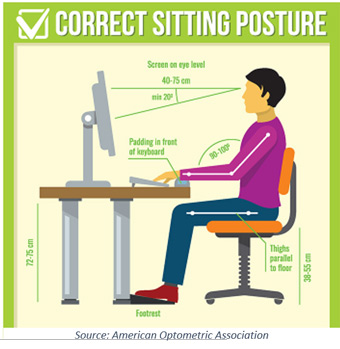Computer Vision Syndrome – A growing concern
Computer Vision Syndrome – A growing concern
Being in a tech-enabled world comes with its own pros and cons. While technology has made information within one’s reach, it has also resulted in various health issues. The dependency on technology has reached its peak that researchers have coined the term ‘computer vision syndrome’. Nearly 50% – 90% of people who make use of computers have at least one of the symptoms.
 What is it?
What is it?Computer Vision Syndrome (CVS) is similar to Carpal Tunnel Syndrome and other repetitive motion injuries. It is also known as Digital Eye Strain.
It occurs due to prolonged use of computers, tablets and mobile phones, and when the eyes follow the same path over and over again. The eyes moving back and forth or looking up and down can strain the muscles in the eyes leading to computer vision syndrome. Individuals with CVS usually experience vision-related issues and eye discomfort, which only increase with the increased usage of digital screen.
Symptoms:
Some of the most common symptoms associated with CVS are –
1.Eyestrain
Eyestrain is a condition that occurs when the eyes get tired due to intense use like driving long distance, staring at digital devices for a long time.
2.Headaches
Headaches are very common in people across different age groups. It can be a sign of stress or emotional distress. Sometimes, even eye-related issues can result in headache.
3.Blurred vision
Blurred vision occurs as a result of loss of sharpness in the eyes. A blurry vision makes objects appear dim and hazy. Exposure to digital devices can lead to a blurred vision, which can further lead to computer vision syndrome.
4.Dry eyes
The eyes become dry when they lack sufficient lubrication and moisture. An important cause of dry eyes is the use of computers and mobile phones. A person using a digital device has his/her gaze fixated on the screen, due to which he/she ends up blinking less frequently. This leads to tear evaporation in the eyes.
5.Neck and shoulder pain
Poor sitting posture while using digital devices can result in neck and shoulder pain. This may further impact the muscles.
6.Double vision
Double vision can occur when a nerve or muscle gets damaged in the eye. This damage to the muscle can result in double vision.
Causes of CVS:
While digital screen is the leading cause for CVS, here are some aspects that lead to the symptoms of CVS –
1.Poor lighting
Poor lighting while using a digital device can lead to numerous eye-related issues.
2.Glare from the screen
Glare on walls and finished surfaces, as well as reflection on computer screen can cause eye strain.
3.Improper viewing distance
The preferred viewing distance for computer is between 20 to 40 inches. A distance lesser than 20 inches can lead to eye issues.
4.Poor seating posture
Poor seating posture or bending too much towards the screen can result in muscle spasms or pain in the back, neck or shoulders.
5.Vision issues
Vision issues like farsightedness, astigmatism, presbyopia, etc. can contribute to the development of CVS.
A combination of the above factors can also lead to CVS.
 Treatment:
Treatment:Here are some effective ways to treat computer vision syndrome –
1.Proper lighting
Good lighting keeps the eyes in good health. The computers/laptops can be positioned in a way to ensure minimal glares.
2.Keep blinking
Blinking helps to maintain the moisture in the eyes. The tear glands wash the eyes naturally.
3.20-20-20 rule
The 20-20-20 rule suggests a person to spend 20 seconds, every 20 minutes looking at something 20 feet away. This is to reduce the strain in the eyes.
4.Proper posture
Maintaining proper posture is a must while viewing digital devices. A proper posture not only helps the eyes, but also the muscles in the neck and the shoulder.
5.Computer glasses
Consulting an optician can also be helpful to procure computer glasses, which can be worn while using digital devices, to reduce strain.
6.Consult a doctor as soon as the symptoms begin to show
The best way to treat computer vision syndrome is by consulting a doctor as soon as the symptoms begin to show.
 Tips for teachers and students:
Tips for teachers and students:Apart from the treatment, here are some tips for educators and students to ensure healthy eyes –
1.Ensure classroom has proper lighting
The classroom has to be well-lit. This does not mean that the light can reflect off computer screens. Classrooms can have blinders and curtains to manage the lighting.
2.Focus on different objects
Teachers can take a break once in a while and look around to reduce the strain in their eyes. Students can also be encouraged to do the same to relax their eyes.
3.Use comfortable text size
While making use of projectors to teach, teachers can keep the texts as large as possible. Using a comfortable text size will reduce the stress in the eyes.
4.Harmon Distance
‘Harmon Distance’ is the distance between the eyes and the object. This is the distance from the elbow to the middle knuckle. Teachers and students can follow this while reading, writing and doing any other work that may stress the eyes.
5.Sit in comfortable yet erect posture
Sitting upright while viewing the digital devices will help reduce back pain and muscular spasms.
Computers can be both beneficial and harmful. To reduce the impact of digital devices, teachers can relax their eyes every once in a while, exercise their eyes and blink as often as possible.





















